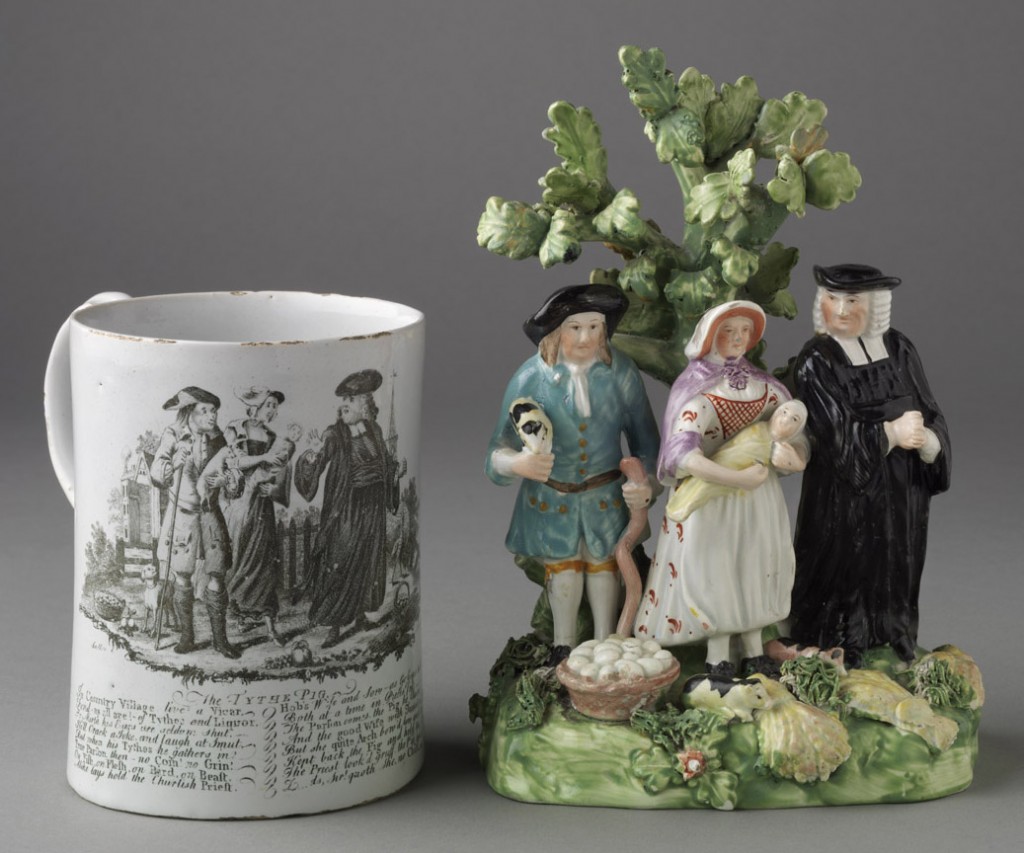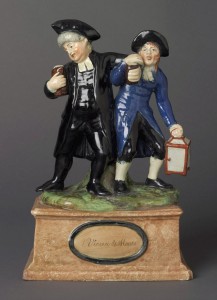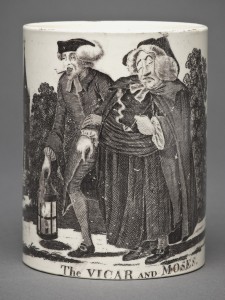Not all objects bearing religious references were complimentary to the church. A number of alcoholic beverage wares bore inscriptions hinting at prejudices against different religions; others provided commentary on perceived bad qualities of some churchmen.
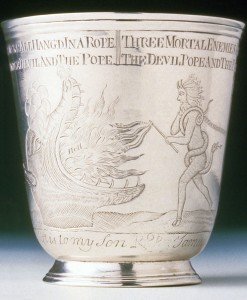
Beaker
Daniel Christian Fueter
New York, New York; 1750–55, dated 1778
Silver
Inscribed with rhymes “This gift to my Son Ro [?] Samuel by his father Saml. Samuel n. York 14 March / 1778” and “D / IM”
Gift of Henry Francis du Pont 1956.521
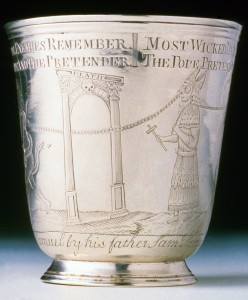 This beaker was made in New York in the 1750s by DanielChristian Fueter. It carries the same engraveddesign by Joseph Leddel that appears on a beaker made in France some 40 years earlier. Both beakers display a fiery-mouth monster with a demon, and an anti-Catholic reference showing the Pope chained by the nose. “The Pretender” is chained by the neck, as an anti-Jacobite reference to ongoing struggles by the Stuarts to regain the British throne after the Glorious Revolution. The rims of the beakers bear the same rhyme :
This beaker was made in New York in the 1750s by DanielChristian Fueter. It carries the same engraveddesign by Joseph Leddel that appears on a beaker made in France some 40 years earlier. Both beakers display a fiery-mouth monster with a demon, and an anti-Catholic reference showing the Pope chained by the nose. “The Pretender” is chained by the neck, as an anti-Jacobite reference to ongoing struggles by the Stuarts to regain the British throne after the Glorious Revolution. The rims of the beakers bear the same rhyme :
 I WISH THEY WERE ALL HANG’D IN A ROPE
I WISH THEY WERE ALL HANG’D IN A ROPE
THE PRETENDERS DEVIL AND THE POPE.
THREE MOTRAL ENEMIES REMEMBER.
THE DEVIL POPE AND THE PRETENDER.
MOST WICKED DAMNABLE AND EVIL.
THE POPE PRETENED[E]R AND THE DEVIL.
Tythe Pig mug
John Sadler (printer)
Liverpool, England; about 1760
Earthenware (delftware)
Inscribed “Sadler Liverpool” with rhyme titled “The Tythe Pig”
Museum purchase with funds provided by the Henry Francis du Pont Collectors Circle 2011.7.4
Tythe Pig figure group
Staffordshire, England; 1805–15
Earthenware (pearlware)
Bequest of Mrs. Helen Shumway Mayer 2003.13.64
The widely popular Tythe Pig story is a commentary on the church and preference for worldly goods over spiritual matters. In the story, a poor farmer and his wife offer one of their many children, rather than their pig, to an astonished Vicar. This subject on a drinking mug suggests its use may have accompanied toasts critical of the church. The subject is also portrayed on English delft wall tiles, on Staffordshire creamware drinking vessels, and is known in musical form as early as 1695 in an arrangement by Henry Purcell.
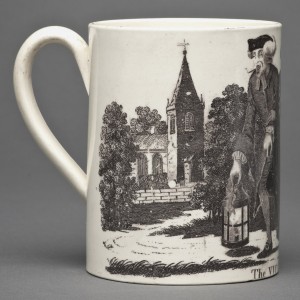 Vicar and Moses figure group
Vicar and Moses figure group
Staffordshire, England; about 1810
Earthenware (pearlware)
Gift of Thomas N. and A. Pat Bernard 2002.30.84
Vicar and Moses mug
Possibly John Aynsley
Lane End, Staffordshire, England; 1785‒1805
Earthenware (creamware)
Gift of John A. and Judith C. Herdeg 2011.18
The Vicar and Moses story was a commentary on the church in England. The scene captures the moment when Moses, the clerk, goes to a tavern to try to get the Vicar to come away and bury a young child. Moses joins the Vicar in drinking, and eventually the two churchmen stumble back to the church, lighting their way with a lantern. Both the print on the mug and the figure group were most likely inspired by a 1785 print published in London by Bowles & Carver.
Related Themes:

